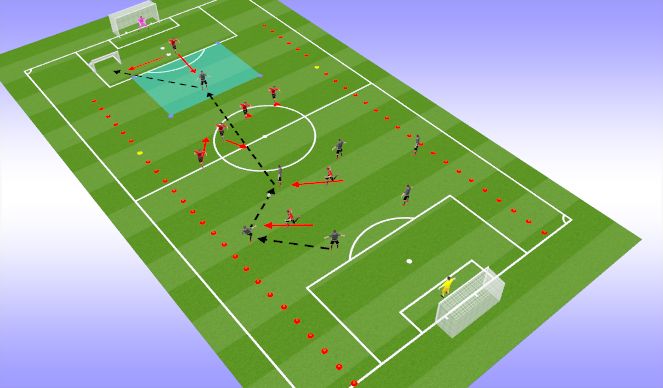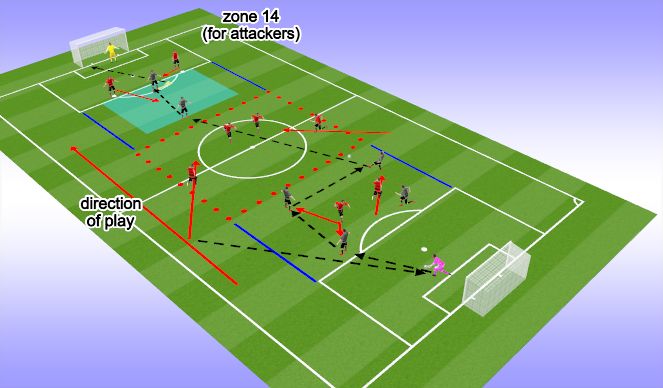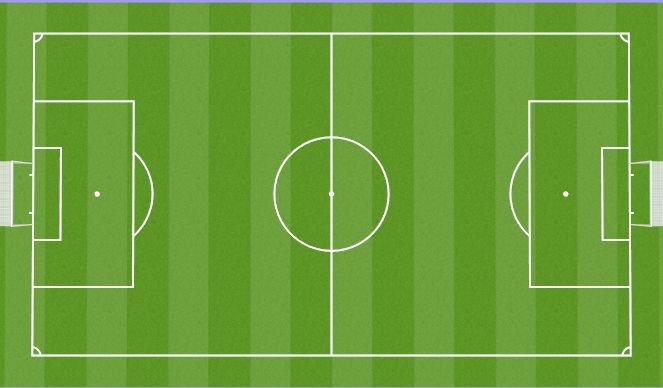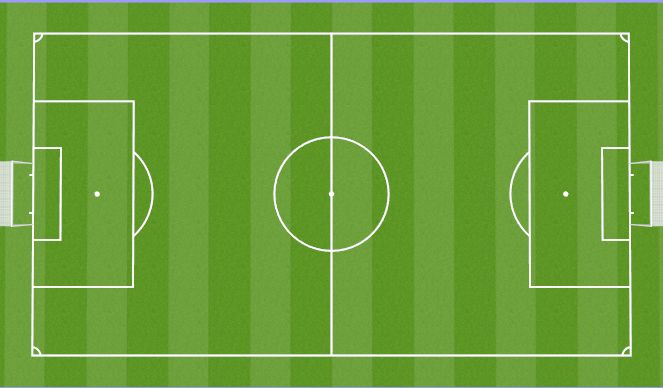Football/Soccer Session (Academy Sessions): Zone 14 attack v defence

Profile Summary

| Name: | Peter Lindgren |
|---|---|
| City: | Ipswich |
| Country: | Australia |
| Membership: | Adult Member |
| Sport: | Football/Soccer |
Description
4-Corner LTPD Model
Technical/Tactical: Main Focus - Defending (Positioning)
Also: Defending Principles, Shootinhg, Passing & Receiving.
Physical: Main Focus - Speed.
Also: Aerobic Endurance.
Psychological: Main Focus - Awareness.
Also: Decision Making.
Social: Main Focus - Teamwork.
Also: Communication & Leadership.

See the guidance at the top of this page to understand why you are not seeing interactive Football/Soccer images.

Whole - First Half (15 mins)
Whole - First Half:
Mark pitch in almost to side of the penalty area to keep practice in central positions. If not or proper pitch with markings. For first half of 'whole' practice have red cones over the top of yellows so it's the same colour for whole sides of the pitch. Blues set up in a 1-1-2-3-1 (1-4-2-3-1 with one just central defender), and reds set up in a 1-4-2-1 (also 1-4-2-3-1 but without wide players and number 9). Use discovery style to begin the session making no interventions and letting them play for at least the first 5 minutes to see if blues can find solutions to the reds getting the ball into the number 10.
Conditions:
1. Normal match rules, although if the ball goes out of play, it is restrated with a pass in and not a throw. Also no corners, only goal kicks.
2. Blue defender must stay on white cone until red number 10 has touched the ball, then he goes live to defend either the small goal or stop the shot from distance.
3. Red number 10 must receive the ball in zone 14 or no points can be scored fro red team (as blue midfield have done their job).
Scoring:
- 1 point for the red team if they can play into their number 10 in zone 14 and he can pass into the smaller goal (recreating sliding his number 9 in for a goalscoring opportunity).
- 2 points if red number 10 can receive in zone 14 and score from the edge of the box against goalkeeper.
- 1 point for blue team if they intercept attempted pass into zone 14.
- 2 points for a goal.
Intervention:
Whole group intervention if shape is unrealistic after 5 minutes.

See the guidance at the top of this page to understand why you are not seeing interactive Football/Soccer images.

Part (30 mins)
Use flat discs to mark out a box for the midfield area the height and depth of the centre circle, and width of the penalthy area; inside the pitch already set up for the 1st half of the 'whole' practice, to help create success and build confidence during the 'part' bit of the practice; ready to go back into the 2nd half of the 'whole' practice.
Brief:
Use Q&A to introduce the practice. Ask who is often the oppositions most dangerous player (answer - number 10). Explain that often he's their most creative player but also the reason why relating to zone 14 - central area between midfield and forwards just outside the box, statistically shown to be the most dangerous area for teams to be in as most goalscoring chances created from this area. Explain that although we like to play a pressing game, when there are none of the triggers we normally use to go press the ball and the opposition are in comfortable posession, what might we then do as a midfield? And how might our formation be flexible and change? (answers - become compact and hard to beat, change into a 1-4-4-2). Just explain the rules of the game, reds have to play into zone 14, and blue midfielders have to stop them. Empower blue team by using a discovery coaching style for the first few minutes to understand the game and try to find their own solutions and see how they defend as a unit before interevning.
What? Stop number 10 receiving the ball in zone 14
How? Adapting our flexible formation when transitioning from in possession to out of possession.
Why? Their number 10 is often the most influencial player and zone 14 is the area of the pitch where the opposition can hurt us most.
Conditions:
1. Blues must stay in marked out central area and cannot go out to press the ball or tackle.
2. Reds in possession must play the ball through to zone 14 below head height.
3. Each time the ball goes dead, the start point alternates to the other goalkeeper.
4. When blues intercept a pass they either knock the ball out to the side or clip it back to a goalkeeper and then the practice will restart.
Interventions:
1. Small group: Be compact, shorten spaces between each midfielder. Imagine holding a rope and keeping that same distance between each of you.
2. Small group: Nike tick or wave shape, moving with the ball and the player closest steps forward to close the gap and apply pressure to the player on the ball.
3. Drive by: Pull quietest midfielder (Rigby) out of session and give him captaincy, to organise the midfield shape and be the main communicator to develop leadership and communication skills.
4. Small group: Stay deep, don't go right up to the line as the amount of time you have to react to close the space between you and intercept the ball is shortened massively by playing too high. Q&A: Ask is a definsive midfielder or central defender likely to drive at you into this middle third while you are compact and risk losing the ball? (answer - no).
Progression 1: *See on next page
Progression 2: *See on page after next

See the guidance at the top of this page to understand why you are not seeing interactive Football/Soccer images.

Part (Progression 1)
Blues are now playing a 1-2-2-3-1 (1-4-2-3-1 without full backs), that changes into a 1-2-4-2 (1-4-4-2 discussed at start of the 'part' practice, without full backs). The reds are now playing a 1-2-2-1-1 (1-4-2-3-1 without full backs or wide attackers). 2 of the reds have now become a blue team 9 & 10, and 2 have become blue central defenders, leaving 4 reds on their defensive third acting as 2 central defenders and 2 defensive midfielders, and a red number 9 & 10 in zone 14. The practice is now single directional for more realism to a match scenario. Practice now starts with a transition. Blue team wide attacking midfielders start wide outside the marked out central area. One of them starts the play off by giving the ball away to the reds' goalkeeper, trying to play a pass into our number 9 or 10. As walking through the practice ask them what those wide players would then do during the transition from in possession, to out of possession (answer - go compact into the midfield 4 like in the previous part of the session). Ask why do we not press? (answer- they identify that the reds would have an overload in their defensive third if in a real match (they would also have 2 full backs and a goalkeeper) and therefore are in comfortable possession, and so they retreat into the compact 1-4-4-2 formation.

See the guidance at the top of this page to understand why you are not seeing interactive Football/Soccer images.

Part (Progression 2)
Create a scenario - blues have a 1 goal lead in the last 5 minutes of the game. Use Q&A: what might happen then to our formation? Tell them not to answer and for them to go into the captain, and they have 30 seconds with their captain, empowering them to come up with a good solution and test Rigby's leadership skills. *A solution could be - make it midfield 5 (1-4-5-1). Let them play using their solution for last 5 minutes of the 'part' before going back into the whole.

See the guidance at the top of this page to understand why you are not seeing interactive Football/Soccer images.

Whole - Second Half (12 mins)
Whole - 2nd Half:
Same set up and scoring system as the first half, only now take red cones off the top to leave yellow cones to highlight middle third as a guide for midfielders.
Interventions:
Shouldn't have to make too many interventions during this final bit of the session.
Progression:
Last 5 minutes of session during 2nd half of 'whole' practice:
Introduce the scenario to the blues that they are a goal up with 5 minutes left. Can they win the game?

See the guidance at the top of this page to understand why you are not seeing interactive Football/Soccer images.

Timeline
Whole (First-Half): (15 mins)
00:00-02:00 introduction to skills practice on whiteboard showing set up, formations and explaining the aims of the game, scoring system, and rules for both teams, then a walk through.
02:00-06:00 - Let them play (discovery style) with no interventions to empower players to find their own solutions during the game.
06:00-07:00 - Group intervention if shape of teams is not realistic to a match and remind them of the importance of realism in practice.
07:00-11:00 - Let them play, just offering fly by or drive by coaching to key individuals at this point if needed.
11:00-12:00 - Whole group intervention to give praise to a player if possible, who has performed something well so far, to increase their confidence and give an example to others of how they should be performing that skill.
12:00-15:00 - Let them play for last 4 minutes before moving into 'part'.
Part: (30 mins)
15:00-18:00 - Drinks break at the whiteboard and go through the set up and conditions of the part, with proper brief for the session (main focus, areas to develop in 4 corners, and the what, how and why of this session) to revisit in debrief. Chance for a good rest period for players also. Set up and walk through.
18:00-21:00 - Let them play and discover how to defend as a midfield 4.
21:00-22:00 - Intervention 1 (small group with midfielders) - shorten distance between them (screen and slide).
22:00-25:00 - Let them play and see if there is imporvement in blocking those passes into zone 14.
25:00-26:00 - Intervention 2 (small group with midfielders) - explain nike tick shape or wave and how you still apply pressure on the ball without having to necessarliy tackle, and how this reduces the gap to pass through due to the angles this creates.
26:00-29:00 - Let them play again, and use intervention 3 (drive by) in this period to give a quiet midfielder who wanted to work on communication/leadership captaincy and see if it can help develop those skills.
29:00-30:00 - Intervention 4, quickly explain how being to high up the pitch means less reaction time to intercept; and how defensive players are unlikely to drive with the ball into a compact midfield.
30:00-33:00 - Let them play with all the new coaching points and see if there is more success than at the start.
33:00-35:00 - Progression 1 - walk through turnover in possession and get players set up in correct positions to add back in that realism to the game.
35:00-39:00 - Let them play with new progression, just use fly by and drive by coaching now if needed.
39:00-40:00 - Add in progression 2 - scenario that blue team are a goal up last 5 minutes. Let them discuss to see if captain can show leadership and to empower players to use commincation skills to come up with a solution.
40:00-45:00 - Let them play hopefully now dropping the 10 in, now defending as a midfield 5. If not and their solution is not working then intervene once more.
Whole (2nd-Half): (12 minutes)
45:00-47:00 - Drinks break and set up for whole practice again, take up red cones to leave yellow underneath as guide for blue midfielders. Q&A: Ask blues what they've learned so far and ask them to implement it all in this last bit of the session.
47:00-52:00 - Only intervene if necessary and seeing no improvement from the 1st-half of the 'whole' practice.
52:00-57:00 - Bring in scenario if not already winning, or just a reminder that it is last 5 minutes and they have a lead.
57:00-1:00:00 - Collect all the equipment and a quick debrief off the pitch.









 Play animation
Play animation Play step-by-step
Play step-by-step Repeat (toggle)
Repeat (toggle) Full Screen
Full Screen Pause
Pause Stop
Stop
Session Rationale
This is a session topic I've been wanting to deliver to Knowsley South for a while now. The reason being that in so many games, I have seen the opposition find it far too easy to break our midfield line and find their most dangerous players - often playing in a No 10 role - between the lines in and around zone 14, which is the kind of position we don't want to allow those players in. Particularly against to top teams in our league. It will also allow our wide attacking players to understand 'when' they should tuck in, into this compact shape, rather than try and press the ball high up the pitch.